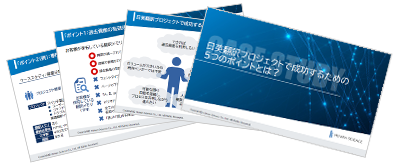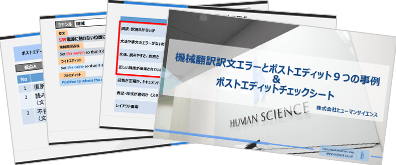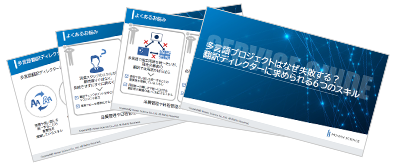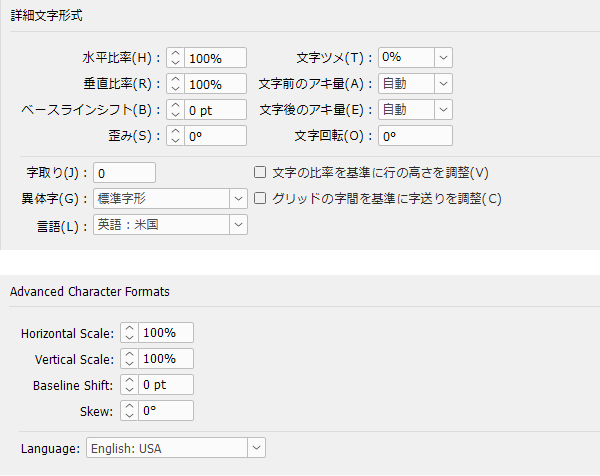
In the field of IT and FA, the frequency of corrections related to pronouns in machine translation post-editing work is high.
The trends regarding pronouns that are often seen in machine translation tools like Google Translate and DeepL can be summarized into three main points.
1. When the subject is difficult to recognize, the formal subject "it (is)" is often used.
2. When the original text contains "~exists", the formal subject "there (is/are)" is often used.
3. When the original text contains "~can", the personal pronoun "you (can)" is often used.
Of course, such trends do not necessarily lead to incorrect translations. Rather, when words like "it" or "there" are used as formal subjects in machine translation, it often results in grammatically correct sentences.
For example, even if a sentence translated by human translators as "This information is difficult to modify." is translated by machine translation as "It is difficult to modify this information.", it is not incorrect in terms of structure or grammar.
However, in the translation of IT and FA fields, there is a tendency to strictly adhere to the rules of technical writing, requiring a concise and easy-to-read structure, grammar, and expression.
Additionally, some companies may prohibit the (excessive) use of pronouns like "you" and formal subjects like "it" and "there". (The reasons for this will be explained in more detail at the end of this blog.)
In other words, when correcting machine translation in the IT and FA fields, it is recommended to eliminate unnecessary formal subjects, antecedents, and ambiguous pronouns as much as possible.
This time, we will introduce how to correct unnecessary pronouns in machine-generated translations from the perspective of the three trends mentioned above.
1. How to correct "it is"①
- ・Original text: The position of the machine body is detected, allowing for high-precision positioning without being affected by machine errors.
- ・Machine Translation: Since the position of the machine body is detected,
it is not affected by machine error and highly accurate positioning is possible
.
- ・After correction: Since the position of the machine main unit is detected,
highly precise positioning can be performed without being affected by machine errors
.
The "it" in the machine translation of "it is not affected..." is structured as if it does not refer to "the position of the machine body," resulting in a mistranslation. Therefore, it is necessary to appropriately make "highly precise positioning" the subject and clarify that the entity not affected is "highly precise positioning."
2. How to Correct "it is"②
- ・Original: It is not usually necessary in practice, but assume that all the storage capacitors have the same capacitance value.
- ・Machine Translation:
It is assumed that
all the storage capacitors have the same capacitance value, which is not usually necessary in practice.
- ・After correction:
Assume that
all the storage capacitors have the same capacitance value, although this is not usually necessary in practice.
The "It" in "It is assumed that" is used as a formal subject. While there are no grammatical or contextual issues, I have revised it to "Assume that" to eliminate unnecessary pronouns.
3. How to Correct 'there is/are'①
- ・Original text: There are two methods for pulse encoders: absolute and incremental.
- ・Machine Translation:
There are two types of pulse coder,
the absolute method and the incremental method.
- ・After correction:
Two methods are available for the pulse coder:
an absolute method and an incremental method.
This "there" is also a formal subject, so there is no grammatical issue, but it has been revised to eliminate unnecessary pronouns and improve readability.
4. How to Correct 'there is/are'②
- ・Original text: There are two ways to share data with other users in this system: "Invite Collaborators" and "Share Link".
- ・Machine Translation:
There are two ways to share data with other users on this system: “Invite Collaborators” and “Share Links”.
- ・After modification:
In this system, the ways to share data with other users are by inviting collaborators or sharing a link.
The term "there" has also been modified from the same perspective as the previous example, as a formal subject.
(Note: Although "Collaborator Invitation" and "Share Link" are in quotation marks, they are not proper nouns or UI elements, so they have been translated as common nouns.)
5. How to Correct 'you'①
- ・Original text: This information can be searched using various methods, such as filtering by keywords and duration.
- ・Machine Translation:
You can search for this information in various ways,
such as by keyword or by time period.
- ・After correction:
Various search methods are available for this information,
such as narrowing the results by keywords or time periods.
In IT and FA field translations, we recommend avoiding unnecessary "you". We have made adjustments from that perspective.
6. How to Correct 'you'②
- ・You can edit, move, and delete signals.
- ・Machine Translation:
You can edit, move and delete signals.
- ・After modification:
A signal can be edited, moved, or deleted.
For the same reason as above, we have used an expression that does not include 'you'.
The machine translation of "~ can ⇒ you can" carries the risk of mistranslation, so caution is necessary. The reason is that "~ can" may not always refer to a person ("you"), but can also refer to a program, system, or device.
In addition, English technical translations are often aimed at a wide audience, including those who are not native English speakers, or serve as the source language for (machine) translation into multiple languages. Therefore, to avoid potential confusion for the reader and mistranslations in multilingual translations, it is recommended to avoid using pronouns that can lead to confusion.





























